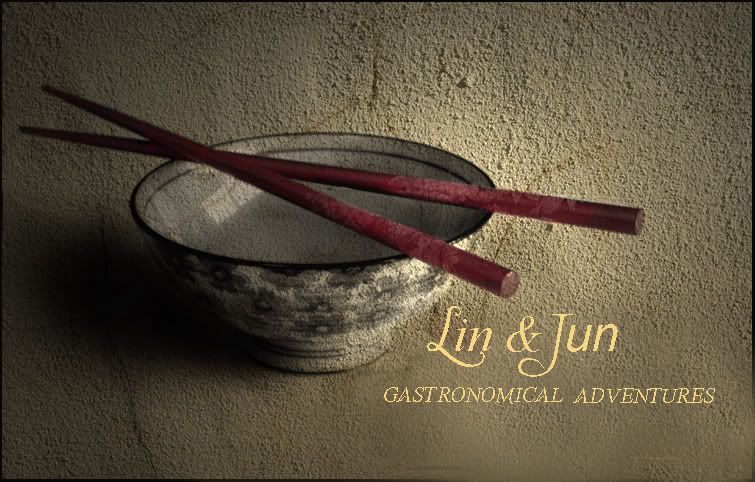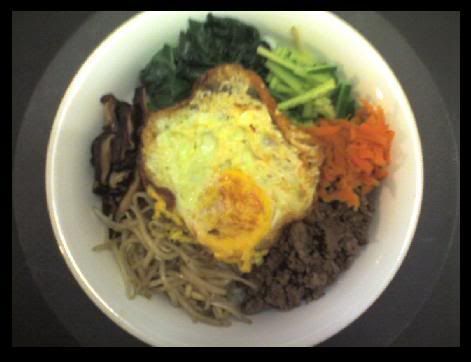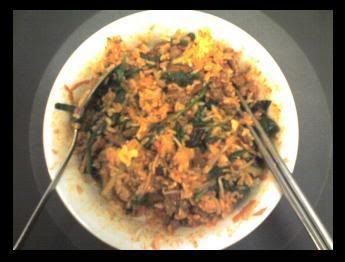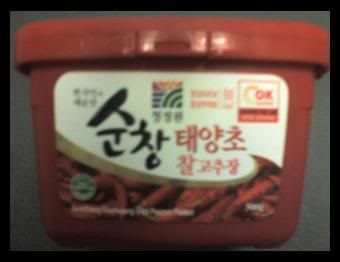 |
|
|
Lin & Jun Profile Lin's Kitchen Dining Out Archives July 2007 September 2007 Taggy |
Sunday, June 10, 2007 My First Attempt At: Korean Bibimbap 비빔밥 Jun and I had a huge craving for Korean Bibimbap since yesterday. So we went to a korean restaurant in Fortitude Valley to get yesterday and it was okay.But didn't satisfy our carving for the real deal. Almost everything here is westernized. We went out today to get some ingredients for my first attempt at bibimbap making. It was alot of work!But the end result! MMMMmmmm-MMMM! Me and Jun are all smiles now!  (I used: Premium Minced Beef, Carrot, Bean Sprouts, Shitake Mushroom, Spinach, Cucumber.And Egg, which I fried till the sides are crispy!) After Mixing it with Gojujang  Gochujang 고추장 - To use Gochujang with Bibimbap, Mix with A little water and Sesame Oil Until smooth.  Gochujang (고추장、苦椒醤) is a spicy Korean condiment, made from glutinous rice powder mixed with powdered fermented soybeans, red chili powder, and salt, and fermented, traditionally in the sun. Other grains can be substituted for the glutinous rice, including normal rice, wheat, and barley. A small amount of sweetener, such as sugar, syrup, or honey is also sometimes added. It is a dark, reddish paste with a rich, spicy flavour. It has been used in Korea since the 16th century, after chili was first introduced. It is used extensively in Korean cooking; for example to flavour stews (jjigae), or to marinate meat. In the Sichuan cuisine of China, a similar paste is called doubanjiang (豆瓣酱)." - Wikipedia Bibimbap 비빔밥 is a popular Korean dish. The word literally means "mixed rice" or "mixed meal." Bibimbap is served as a bowl of warm white rice topped with sauteed and seasoned vegetables, beef, a fried egg, and gochujang (chile pepper paste). The ingredients are stirred together thoroughly just before eating. It can be served either cold or hot. Vegetables commonly used in bibimbap include julienned cucumber, zucchini, carrot, mu (white radish), mushrooms, doraji (bellflower root), and laver, as well as spinach, soybean sprouts, and gosari (bracken fern stems). Dubu (tofu), either plain or sauteed, or a leaf of lettuce may be added, or beef may be substituted with chicken or seafood. Many areas of Korea typically serve a vegetarian version of the dish which may well be the more traditional alternative. A variation of this dish, dolsot bibimbap (돌솥 비빔밥, "dolsot" meaning "stone pot"), is served in a heated stone bowl, in which a raw egg is cooked against the sides of the bowl. Before the rice is placed in the bowl, the bottom of the bowl is coated with sesame oil, making the layer of the rice touching the bowl golden brown and crispy." - Wikipedia  With Love From Lin's Kitchen |
Post a Comment
<< Go Back and Watch me Fumble